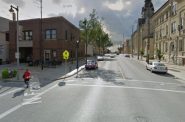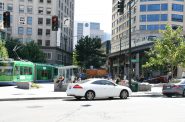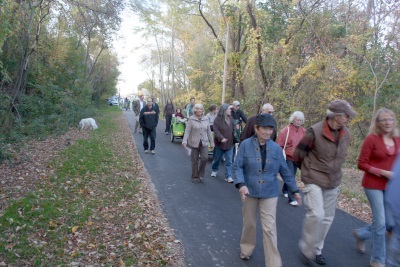The Physical Benefits of Biking and Walking Paths
Study shows people living near trails get more exercise, leading to better health.
People who live near safe, high-quality biking and walking infrastructure tend to get more exercise than people who don’t, according to a study published last week in the American Journal of Public Health.
Researchers surveyed randomly selected adults before and after new bike/ped infrastructure was built in three communities in the U.K. Two of the selected communities opened bike and pedestrian bridges with well-connected “feeder” infrastructure. The other community upgraded “an informal riverside footpath” into a boardwalk during the study period.
Over two years, about 1,500 people responded to annual surveys about their walking and biking habits as well as other exercise behavior. During the first year of the survey — before the bike/ped improvements had been completed — there was no difference in biking and walking levels between people living close to the project areas and people living farther away. But by the final survey year, after the new infrastructure had been built, a disparity began to emerge.
Researchers found that people living within 0.6 miles of a protected bikeway got about 45 minutes more exercise biking and walking per week than people living 2.5 miles away. For every kilometer (0.6 miles) closer respondents lived to the infrastructure improvement, they exercised roughly 15 minutes more per week. People without access to a car were most likely to exercise more in response to the infrastructure improvements.
Importantly, researchers found there was no corresponding decrease in other types of physical activity — meaning access to biking and walking infrastructure helped increase overall physical activity levels for nearby residents.
The study’s lead author, Dr. Anne Goodman of the University of Cambridge, said that this type of infrastructure could be a key to the fight against obesity and diabetes.
“These findings support the case for changing the environment to promote physical activity by making walking and cycling safer, more convenient and more attractive,” she said in a statement.
Could More Trails Benefit Wisconsin?
The short answer is yes.
In fact a 2011 review of more than 200 studies by the American Heart Association found: “Every $1 spent on building biking trails and walking paths could save approximately $3 in medical expenses.”
With 29.7 percent of adult Wisconsin residents considered obese, Wisconsin is unfortunately the 15th most obese state in the nation. And this is costing us billions.
The 2012 Trust for America’s Health and Robert Wood Johnson Foundation’s report “Bending the Obesity Cost Curve in Wisconsin” found that if the body mass index (a calculation based on an individual’s weight and height) of the average Wisconsinite could be reduced just 5 percent, this could save $11 billion over a 20 year period. This saving would be generated by preventing cases of type 2 diabetes, coronary heart disease and stroke, hypertension, and cancer and arthritis.
Not to mention that biking and walking are fun. – Dave Reid
Story by Angie Schmitt with additional contributions from Dave Reid of Urban Milwaukee. A version of this story originally ran on Streetsblog. Angie Schmitt is a newspaper reporter-turned planner/advocate who manages the Streetsblog Network from glamorous Cleveland, Ohio. She also writes about urban issues particular to the industrial Midwest at Rustwire.com.
Streetsblog
-
Car Culture Cements Suburban Politics
![Sprawl. Photo by David Shankbone (David Shankbone) [GFDL (http://www.gnu.org/copyleft/fdl.html) or CC-BY-SA-3.0 (http://creativecommons.org/licenses/by-sa/3.0/)], via Wikimedia Commons [ https://commons.wikimedia.org/wiki/File%3ASuburbia_by_David_Shankbone.jpg ]](https://urbanmilwaukee.com/wp-content/uploads/2017/10/1024px-Suburbia_by_David_Shankbone-185x122.jpg) Nov 23rd, 2018 by Angie Schmitt
Nov 23rd, 2018 by Angie Schmitt
-
Most Drivers Don’t Yield to Pedestrians
 Mar 22nd, 2018 by Angie Schmitt
Mar 22nd, 2018 by Angie Schmitt
-
Jobs Up Yet Driving Down in Seattle
 Feb 22nd, 2018 by Angie Schmitt
Feb 22nd, 2018 by Angie Schmitt






















These paths are Godsend, we need more. I ride them every day that there is not any snow or ice. My dog: “Nancy Reagan”, runs alongside to get in shape for hunting season.
@WCD Agreed. I do love our trail system(s), and look forward to every new section that opens.
All the trails are great for walkers and bikers. We need more on the South Side. All the main parks could be connected with a path on the old Lakeside right-of-way (owned by We Energies) that runs parallel with I-894, all the way to the Lakefront and could connect up with the Hank Aaron Trail near the Zoo Interchange to wrap around the entire Metro area. There are also a number of creek, river channels like Wilson, Kinnickinnic, Zablocki, with County or City ownership that could branch and feed this main artery on the South Side. Further connections could be made with trail connections to the surrounding counties.
This seems like proof that they are doing good work up in Sheboygan, despite what some naysayers have claimed.
PMD, typical leftist response. Sheboygan spent millions of our tax money and nothing happened, actually got little worse and you think they are doing good work. No wonder the Left cannot fix anything in Milwaukee and then try to get rid of anyone that does do things right like Walker and Clarke. They show you up for what you are, a bunch of clowns.
I noted the benefits of what is happening up in Sheboygan. Allow me to repeat myself:
“Far more walking, improved public health, far fewer biking accidents, and enhanced accessibility and visibility for bikers.”
So are you intentionally ignoring those? Or are you claiming that those are not accomplishments? And above you state that we need more walking and biking paths, so aren’t you contradicting yourself?
PMD report says none of that has happened.
Ok finally looked at the “Sheboygan” study (really the NTPP). http://www.fhwa.dot.gov/environment/bicycle_pedestrian/ntpp/2014_report/page03.cfm. I’ll point out that more logical comparison for Milwaukee in the study is Minneapolis, and gee they did have growth in pedestrians and bicyclists. In fact so did Columbia, and Marion County I guess Media Trackers just missed that part. Only Sheboygan was flat/down 1 (it had increased until significant construction started which you guessed it was not in that story) and the biggest part of the entire project in relation to bikes has not been completed, it doesn’t open to 2015 so again the study is premature (yet another key fact that doesn’t appear to have been mentioned). Now, that all said Sheboygan was clearly the biggest stretch of the cities on the list as its starting point was much lower as far as counts which also makes it a poor comparison to Milwaukee.
Another note on the Sheboygan study:
“After early implementation of smaller scale NTPP projects, however, Sheboygan County has measured a substantial increase in walking between 2009 and 2013. Since sidewalks are inherently less costly and easier to construct than large-scale projects like multiuse pathways, these were some of the first accommodations to reach completion. Walking counts nearly doubled each of the first three years and have continued to show considerable growth at the count locations.” They spent on walking first, and it went up.
David, you are right. That is a good expenditure of public money cause they are heavily used. The Sheboygan fed report shows that the money spent to stimulate other programs for cycling did not work by the bike paths are heavily used cause they are safe. Every day I see women with baby carriages, kids, old timers biking, walking etc. These programs where we send cyclists down main trunk hiways in urban areas are nuts. Keep to side streets. Even if you have the right of way, you lose in a collision and seldom does the driver get charged cause they just did not see them. Have lost 4 friends.
There’s still so many sections of the oak leaf that are disconnected/disjointed. I’d love to see it connected with real paths and trails when it’s not on a parkway.
I wonder if we can raise more funds for our bike trail system by following the Waukesha county system of requiring permits to use the trail? or some sort of user fee anyway. I do not believe our bike system needs to be self funded, but it would be another source of income to create ever more infrastructure.
Yes it does WCD. I read it. I even included the parts of the report that state those results in other posts. You are either ignoring those positive results or claiming they are not accomplishments. From the report, for Sheboygan County:
-Walking increased an estimated 85 percent (thereby improving public health)
-Pedestrian and bicycle injuries declined. Charts are here: http://www.fhwa.dot.gov/environment/bicycle_pedestrian/ntpp/2014_report/page04.cfm#Toc386019770
-Sheboygan County, however, completed over $10 million of NTPP- and municipal-funded bicycle and pedestrian projects in 2013, which now provide better accessibility, safety, and visibility for bicycle users. The most highly anticipated and expensive project, a three mile multiuse path, is expected to show promising results once construction is completed in 2015.
And again, above in comment #1, you state that we need more walking and biking paths, so aren’t you contradicting yourself?
Healthy lifestyles and quality of life issues do pay for themselves many times over by keeping people out of hospitals and nursing homes. This reduces health care costs for everyone. Off street bike and walking paths are safer – keeps people from getting killed and maimed. DOT funds have been used for pathway construction as they should be as part of an overall transportation fund that we all pay into. Private donations are also used for many trail developments. Many of the trails have been established on We Energies electric corridors, and on old unused rail beds.
Walking is great, I love cycling, but we are spending money on projects that are not making sense like these bike things on busy roads or over the bridges. Stay off busy roads and heavily traveled hiways and stay alive.
David Ciepluch, just for clarification… you’re against any sort of user fee for using trails?
I’m not saying we stop using some transportation funds, I’m just thinking that even if 50-200,000 people each paid an annual $10 fee, we could potentially see millions of dollars in extra revenue to get more projects off the ground.
@Andy How about we just allocate all sales tax connected with the bicycle industry to fund trails. I’m all for that. Heck even a fee when buying a new bike would be fine (shouldn’t be too hard to manage).. But I’ve got to think administration of the yearly fees would not work terribly well.
David, people have been pushing ideas like this for decades and it will not happen. No new taxes and to start doing what you want would be quickly taken up by dozens of other groups so that will not happen. This has to be worked into tour present budgets and that means holding down spending on other projects and controlling the biggest expenditures of govt. Public employees. Why should public employees get better salaries, pensions, bennies, vacations, health, dental, days off, sick pay etc. than we do, the taxpayers?
Many of the trail systems have been backed and received funding and support through nonprofit organizations with grant writing and thousands of hours of volunteer labor. It takes a lot of collaboration and planning between multiple government, land owners, nonprofit organizations, etc. The Hank Aaron, Ozaukee County Trails would not have happened without contributions by all the above.
I would gladly pay $10 annually and even more on auto license fee (optional) and other ideas mentioned for trail advancements.
David, I would too, even up to 25 dollars but how to do it? there is not nay mood to raise taxes anywhere.
Just got back from ride on bike path with my dog. Tons of people even at this time of day. I think that it must come from regular budgets. if public employees paid the same percent for their health care that we have done in private sector we would be fine.
There’s optional fees on auto registration already for things like conservation… whats one more to support trails and other biking infrastructure? I like the optional route.
Get licnese plate like Packers, UW, DU.
Well isn’t this a refreshing thread. Most people are agreeing most of the time and coming up with constructive ideas.
No doubt about benefits of Biking and Walking. Thanks for the post.